Free Trade Agreements: Impact Analysis on US and TPP Economies
VerifiedAdded on 2020/03/16
|23
|4750
|164
Report
AI Summary
This report provides a detailed analysis of free trade agreements (FTAs), with a specific focus on the Trans-Pacific Partnership (TPP). It begins by defining FTAs and their advantages, such as economic growth, technology transfer, and increased foreign investment. The report then examines the TPP, its objectives, and the impact of the US withdrawal under the Trump administration. It explores the potential consequences of this withdrawal on both US consumers and producers, as well as the remaining TPP member countries. The analysis includes an assessment of the TPP11's viability and the effects of the US absence on trade dynamics. The report concludes by evaluating the impacts of the TPP on various sectors, particularly agriculture, and provides insights into the effects of tariff and quota reductions on consumers and producers within the involved economies.
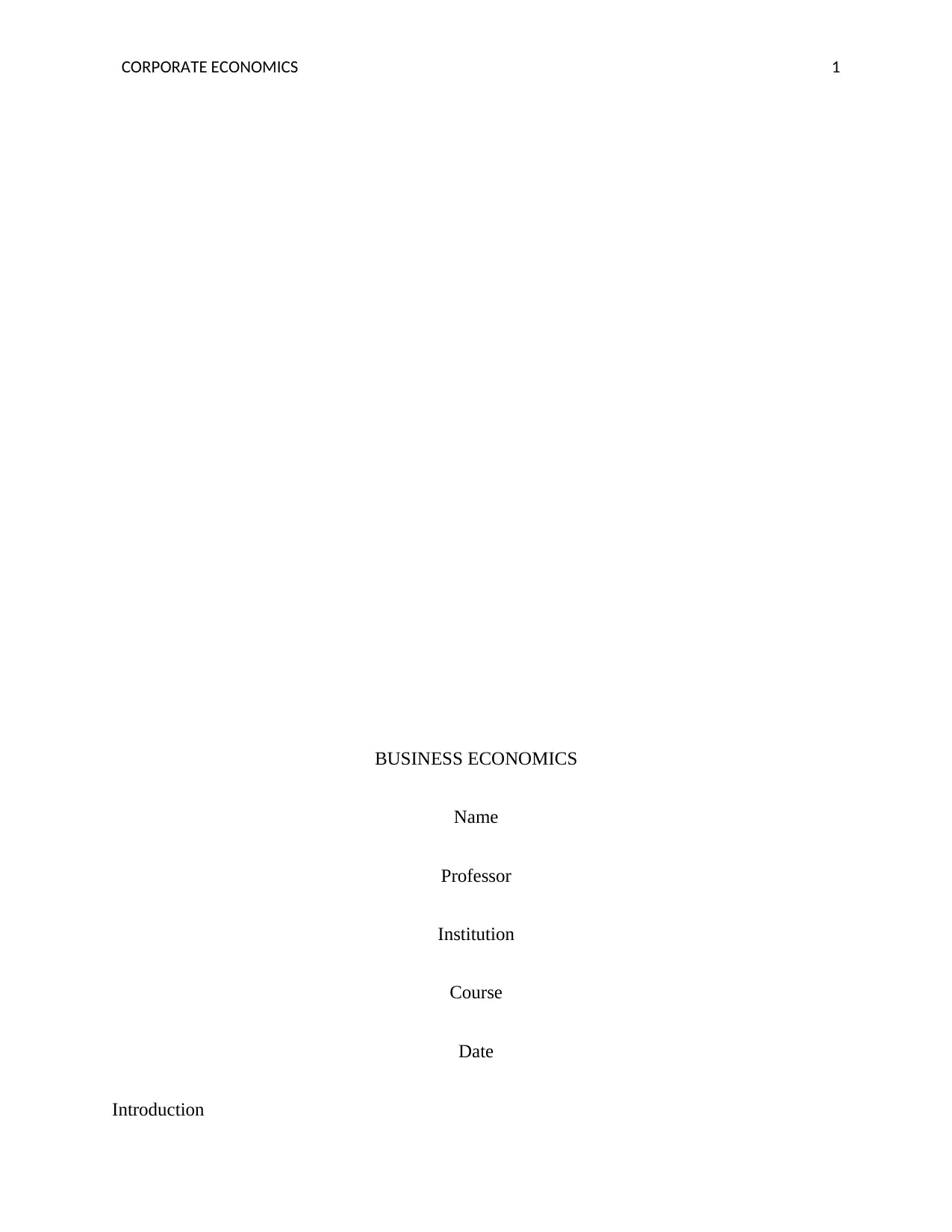
CORPORATE ECONOMICS 1
BUSINESS ECONOMICS
Name
Professor
Institution
Course
Date
Introduction
BUSINESS ECONOMICS
Name
Professor
Institution
Course
Date
Introduction
Paraphrase This Document
Need a fresh take? Get an instant paraphrase of this document with our AI Paraphraser
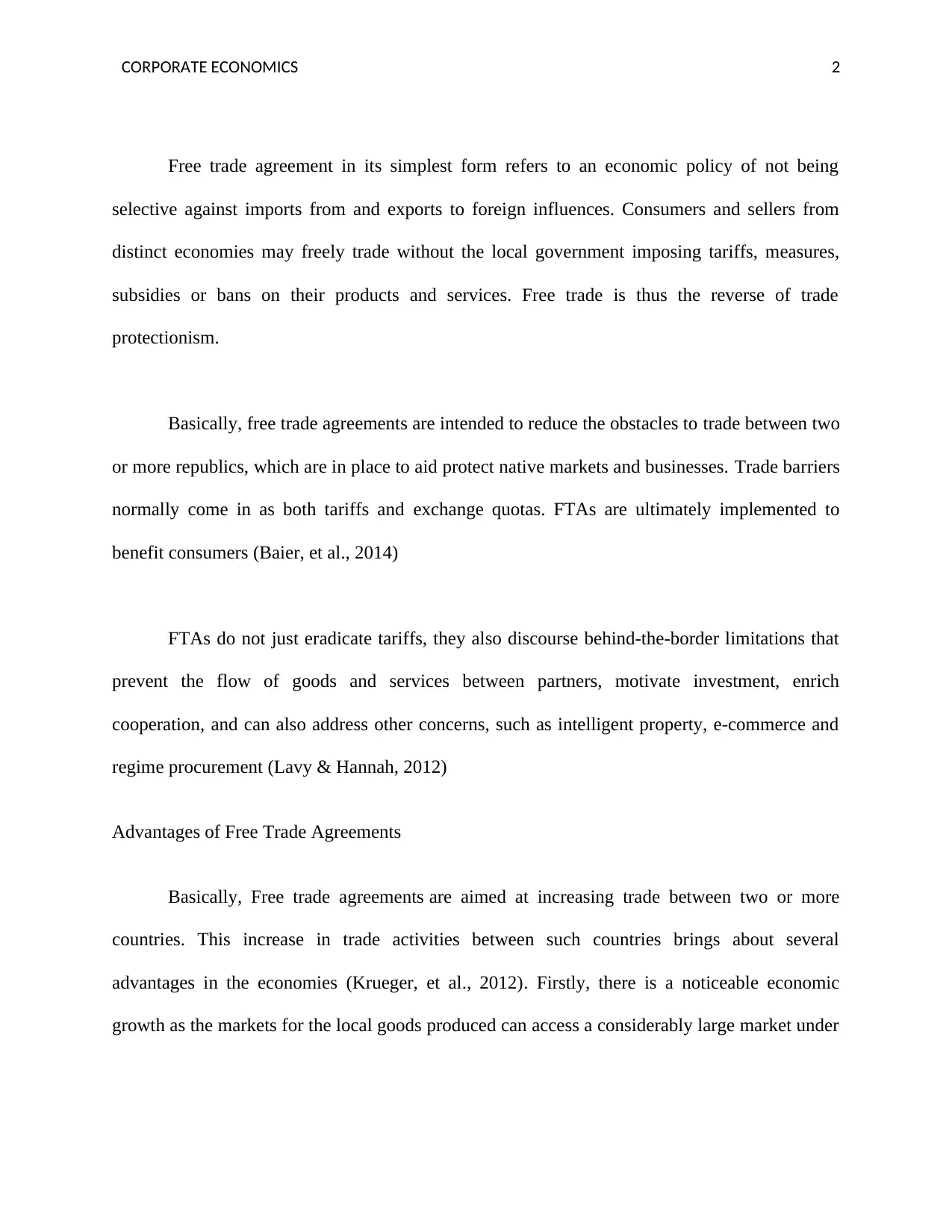
CORPORATE ECONOMICS 2
Free trade agreement in its simplest form refers to an economic policy of not being
selective against imports from and exports to foreign influences. Consumers and sellers from
distinct economies may freely trade without the local government imposing tariffs, measures,
subsidies or bans on their products and services. Free trade is thus the reverse of trade
protectionism.
Basically, free trade agreements are intended to reduce the obstacles to trade between two
or more republics, which are in place to aid protect native markets and businesses. Trade barriers
normally come in as both tariffs and exchange quotas. FTAs are ultimately implemented to
benefit consumers (Baier, et al., 2014)
FTAs do not just eradicate tariffs, they also discourse behind-the-border limitations that
prevent the flow of goods and services between partners, motivate investment, enrich
cooperation, and can also address other concerns, such as intelligent property, e-commerce and
regime procurement (Lavy & Hannah, 2012)
Advantages of Free Trade Agreements
Basically, Free trade agreements are aimed at increasing trade between two or more
countries. This increase in trade activities between such countries brings about several
advantages in the economies (Krueger, et al., 2012). Firstly, there is a noticeable economic
growth as the markets for the local goods produced can access a considerably large market under
Free trade agreement in its simplest form refers to an economic policy of not being
selective against imports from and exports to foreign influences. Consumers and sellers from
distinct economies may freely trade without the local government imposing tariffs, measures,
subsidies or bans on their products and services. Free trade is thus the reverse of trade
protectionism.
Basically, free trade agreements are intended to reduce the obstacles to trade between two
or more republics, which are in place to aid protect native markets and businesses. Trade barriers
normally come in as both tariffs and exchange quotas. FTAs are ultimately implemented to
benefit consumers (Baier, et al., 2014)
FTAs do not just eradicate tariffs, they also discourse behind-the-border limitations that
prevent the flow of goods and services between partners, motivate investment, enrich
cooperation, and can also address other concerns, such as intelligent property, e-commerce and
regime procurement (Lavy & Hannah, 2012)
Advantages of Free Trade Agreements
Basically, Free trade agreements are aimed at increasing trade between two or more
countries. This increase in trade activities between such countries brings about several
advantages in the economies (Krueger, et al., 2012). Firstly, there is a noticeable economic
growth as the markets for the local goods produced can access a considerably large market under
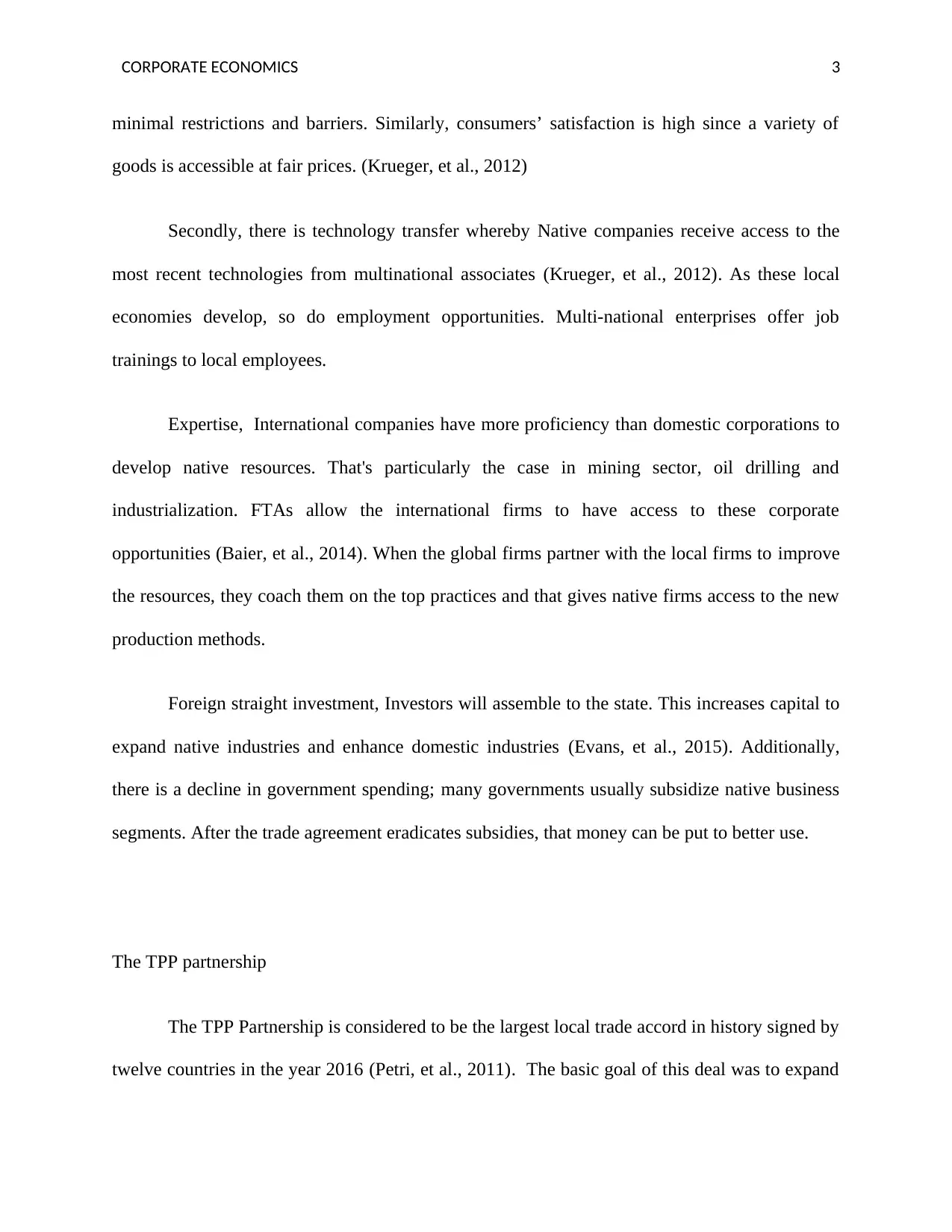
CORPORATE ECONOMICS 3
minimal restrictions and barriers. Similarly, consumers’ satisfaction is high since a variety of
goods is accessible at fair prices. (Krueger, et al., 2012)
Secondly, there is technology transfer whereby Native companies receive access to the
most recent technologies from multinational associates (Krueger, et al., 2012). As these local
economies develop, so do employment opportunities. Multi-national enterprises offer job
trainings to local employees.
Expertise, International companies have more proficiency than domestic corporations to
develop native resources. That's particularly the case in mining sector, oil drilling and
industrialization. FTAs allow the international firms to have access to these corporate
opportunities (Baier, et al., 2014). When the global firms partner with the local firms to improve
the resources, they coach them on the top practices and that gives native firms access to the new
production methods.
Foreign straight investment, Investors will assemble to the state. This increases capital to
expand native industries and enhance domestic industries (Evans, et al., 2015). Additionally,
there is a decline in government spending; many governments usually subsidize native business
segments. After the trade agreement eradicates subsidies, that money can be put to better use.
The TPP partnership
The TPP Partnership is considered to be the largest local trade accord in history signed by
twelve countries in the year 2016 (Petri, et al., 2011). The basic goal of this deal was to expand
minimal restrictions and barriers. Similarly, consumers’ satisfaction is high since a variety of
goods is accessible at fair prices. (Krueger, et al., 2012)
Secondly, there is technology transfer whereby Native companies receive access to the
most recent technologies from multinational associates (Krueger, et al., 2012). As these local
economies develop, so do employment opportunities. Multi-national enterprises offer job
trainings to local employees.
Expertise, International companies have more proficiency than domestic corporations to
develop native resources. That's particularly the case in mining sector, oil drilling and
industrialization. FTAs allow the international firms to have access to these corporate
opportunities (Baier, et al., 2014). When the global firms partner with the local firms to improve
the resources, they coach them on the top practices and that gives native firms access to the new
production methods.
Foreign straight investment, Investors will assemble to the state. This increases capital to
expand native industries and enhance domestic industries (Evans, et al., 2015). Additionally,
there is a decline in government spending; many governments usually subsidize native business
segments. After the trade agreement eradicates subsidies, that money can be put to better use.
The TPP partnership
The TPP Partnership is considered to be the largest local trade accord in history signed by
twelve countries in the year 2016 (Petri, et al., 2011). The basic goal of this deal was to expand
⊘ This is a preview!⊘
Do you want full access?
Subscribe today to unlock all pages.

Trusted by 1+ million students worldwide
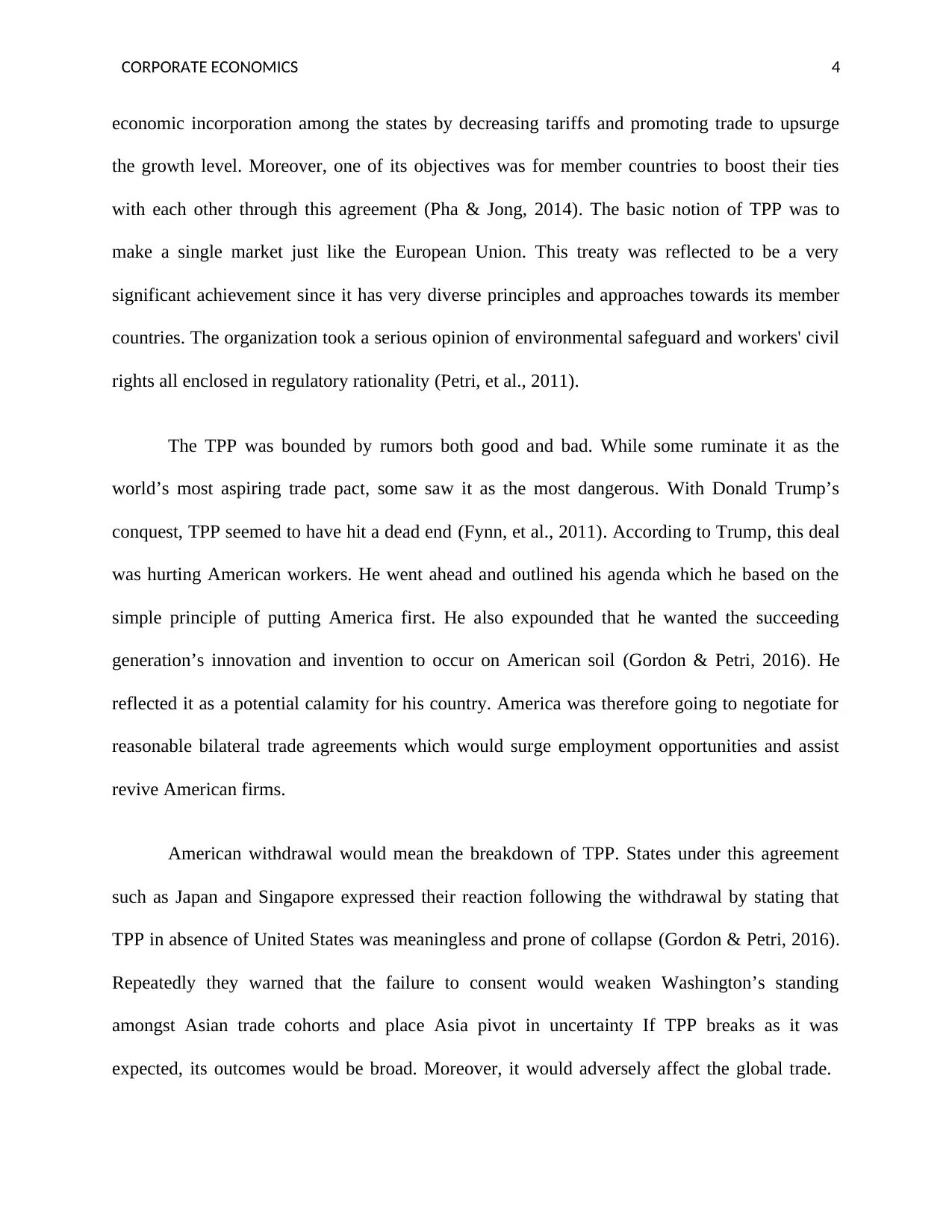
CORPORATE ECONOMICS 4
economic incorporation among the states by decreasing tariffs and promoting trade to upsurge
the growth level. Moreover, one of its objectives was for member countries to boost their ties
with each other through this agreement (Pha & Jong, 2014). The basic notion of TPP was to
make a single market just like the European Union. This treaty was reflected to be a very
significant achievement since it has very diverse principles and approaches towards its member
countries. The organization took a serious opinion of environmental safeguard and workers' civil
rights all enclosed in regulatory rationality (Petri, et al., 2011).
The TPP was bounded by rumors both good and bad. While some ruminate it as the
world’s most aspiring trade pact, some saw it as the most dangerous. With Donald Trump’s
conquest, TPP seemed to have hit a dead end (Fynn, et al., 2011). According to Trump, this deal
was hurting American workers. He went ahead and outlined his agenda which he based on the
simple principle of putting America first. He also expounded that he wanted the succeeding
generation’s innovation and invention to occur on American soil (Gordon & Petri, 2016). He
reflected it as a potential calamity for his country. America was therefore going to negotiate for
reasonable bilateral trade agreements which would surge employment opportunities and assist
revive American firms.
American withdrawal would mean the breakdown of TPP. States under this agreement
such as Japan and Singapore expressed their reaction following the withdrawal by stating that
TPP in absence of United States was meaningless and prone of collapse (Gordon & Petri, 2016).
Repeatedly they warned that the failure to consent would weaken Washington’s standing
amongst Asian trade cohorts and place Asia pivot in uncertainty If TPP breaks as it was
expected, its outcomes would be broad. Moreover, it would adversely affect the global trade.
economic incorporation among the states by decreasing tariffs and promoting trade to upsurge
the growth level. Moreover, one of its objectives was for member countries to boost their ties
with each other through this agreement (Pha & Jong, 2014). The basic notion of TPP was to
make a single market just like the European Union. This treaty was reflected to be a very
significant achievement since it has very diverse principles and approaches towards its member
countries. The organization took a serious opinion of environmental safeguard and workers' civil
rights all enclosed in regulatory rationality (Petri, et al., 2011).
The TPP was bounded by rumors both good and bad. While some ruminate it as the
world’s most aspiring trade pact, some saw it as the most dangerous. With Donald Trump’s
conquest, TPP seemed to have hit a dead end (Fynn, et al., 2011). According to Trump, this deal
was hurting American workers. He went ahead and outlined his agenda which he based on the
simple principle of putting America first. He also expounded that he wanted the succeeding
generation’s innovation and invention to occur on American soil (Gordon & Petri, 2016). He
reflected it as a potential calamity for his country. America was therefore going to negotiate for
reasonable bilateral trade agreements which would surge employment opportunities and assist
revive American firms.
American withdrawal would mean the breakdown of TPP. States under this agreement
such as Japan and Singapore expressed their reaction following the withdrawal by stating that
TPP in absence of United States was meaningless and prone of collapse (Gordon & Petri, 2016).
Repeatedly they warned that the failure to consent would weaken Washington’s standing
amongst Asian trade cohorts and place Asia pivot in uncertainty If TPP breaks as it was
expected, its outcomes would be broad. Moreover, it would adversely affect the global trade.
Paraphrase This Document
Need a fresh take? Get an instant paraphrase of this document with our AI Paraphraser
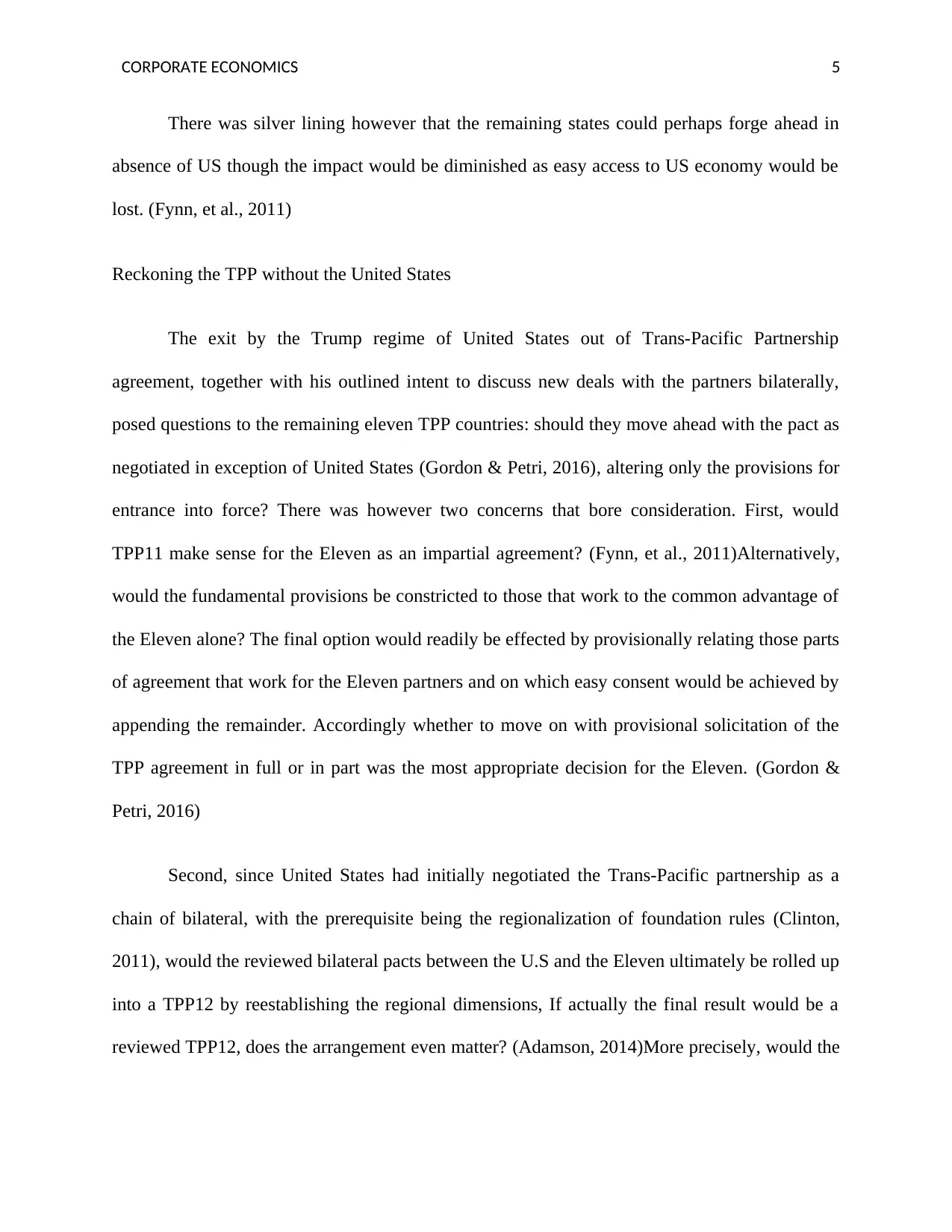
CORPORATE ECONOMICS 5
There was silver lining however that the remaining states could perhaps forge ahead in
absence of US though the impact would be diminished as easy access to US economy would be
lost. (Fynn, et al., 2011)
Reckoning the TPP without the United States
The exit by the Trump regime of United States out of Trans-Pacific Partnership
agreement, together with his outlined intent to discuss new deals with the partners bilaterally,
posed questions to the remaining eleven TPP countries: should they move ahead with the pact as
negotiated in exception of United States (Gordon & Petri, 2016), altering only the provisions for
entrance into force? There was however two concerns that bore consideration. First, would
TPP11 make sense for the Eleven as an impartial agreement? (Fynn, et al., 2011)Alternatively,
would the fundamental provisions be constricted to those that work to the common advantage of
the Eleven alone? The final option would readily be effected by provisionally relating those parts
of agreement that work for the Eleven partners and on which easy consent would be achieved by
appending the remainder. Accordingly whether to move on with provisional solicitation of the
TPP agreement in full or in part was the most appropriate decision for the Eleven. (Gordon &
Petri, 2016)
Second, since United States had initially negotiated the Trans-Pacific partnership as a
chain of bilateral, with the prerequisite being the regionalization of foundation rules (Clinton,
2011), would the reviewed bilateral pacts between the U.S and the Eleven ultimately be rolled up
into a TPP12 by reestablishing the regional dimensions, If actually the final result would be a
reviewed TPP12, does the arrangement even matter? (Adamson, 2014)More precisely, would the
There was silver lining however that the remaining states could perhaps forge ahead in
absence of US though the impact would be diminished as easy access to US economy would be
lost. (Fynn, et al., 2011)
Reckoning the TPP without the United States
The exit by the Trump regime of United States out of Trans-Pacific Partnership
agreement, together with his outlined intent to discuss new deals with the partners bilaterally,
posed questions to the remaining eleven TPP countries: should they move ahead with the pact as
negotiated in exception of United States (Gordon & Petri, 2016), altering only the provisions for
entrance into force? There was however two concerns that bore consideration. First, would
TPP11 make sense for the Eleven as an impartial agreement? (Fynn, et al., 2011)Alternatively,
would the fundamental provisions be constricted to those that work to the common advantage of
the Eleven alone? The final option would readily be effected by provisionally relating those parts
of agreement that work for the Eleven partners and on which easy consent would be achieved by
appending the remainder. Accordingly whether to move on with provisional solicitation of the
TPP agreement in full or in part was the most appropriate decision for the Eleven. (Gordon &
Petri, 2016)
Second, since United States had initially negotiated the Trans-Pacific partnership as a
chain of bilateral, with the prerequisite being the regionalization of foundation rules (Clinton,
2011), would the reviewed bilateral pacts between the U.S and the Eleven ultimately be rolled up
into a TPP12 by reestablishing the regional dimensions, If actually the final result would be a
reviewed TPP12, does the arrangement even matter? (Adamson, 2014)More precisely, would the
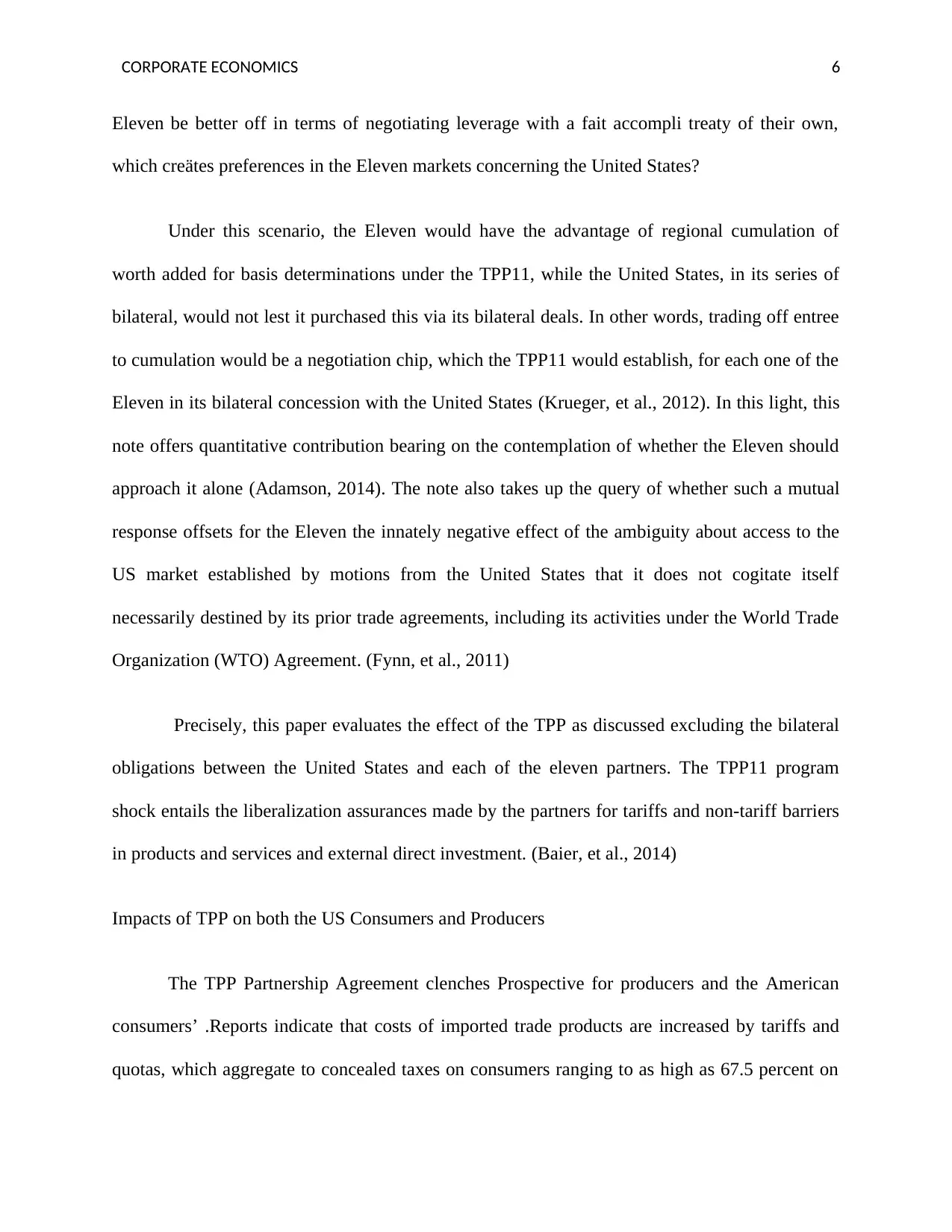
CORPORATE ECONOMICS 6
Eleven be better off in terms of negotiating leverage with a fait accompli treaty of their own,
which creätes preferences in the Eleven markets concerning the United States?
Under this scenario, the Eleven would have the advantage of regional cumulation of
worth added for basis determinations under the TPP11, while the United States, in its series of
bilateral, would not lest it purchased this via its bilateral deals. In other words, trading off entree
to cumulation would be a negotiation chip, which the TPP11 would establish, for each one of the
Eleven in its bilateral concession with the United States (Krueger, et al., 2012). In this light, this
note offers quantitative contribution bearing on the contemplation of whether the Eleven should
approach it alone (Adamson, 2014). The note also takes up the query of whether such a mutual
response offsets for the Eleven the innately negative effect of the ambiguity about access to the
US market established by motions from the United States that it does not cogitate itself
necessarily destined by its prior trade agreements, including its activities under the World Trade
Organization (WTO) Agreement. (Fynn, et al., 2011)
Precisely, this paper evaluates the effect of the TPP as discussed excluding the bilateral
obligations between the United States and each of the eleven partners. The TPP11 program
shock entails the liberalization assurances made by the partners for tariffs and non-tariff barriers
in products and services and external direct investment. (Baier, et al., 2014)
Impacts of TPP on both the US Consumers and Producers
The TPP Partnership Agreement clenches Prospective for producers and the American
consumers’ .Reports indicate that costs of imported trade products are increased by tariffs and
quotas, which aggregate to concealed taxes on consumers ranging to as high as 67.5 percent on
Eleven be better off in terms of negotiating leverage with a fait accompli treaty of their own,
which creätes preferences in the Eleven markets concerning the United States?
Under this scenario, the Eleven would have the advantage of regional cumulation of
worth added for basis determinations under the TPP11, while the United States, in its series of
bilateral, would not lest it purchased this via its bilateral deals. In other words, trading off entree
to cumulation would be a negotiation chip, which the TPP11 would establish, for each one of the
Eleven in its bilateral concession with the United States (Krueger, et al., 2012). In this light, this
note offers quantitative contribution bearing on the contemplation of whether the Eleven should
approach it alone (Adamson, 2014). The note also takes up the query of whether such a mutual
response offsets for the Eleven the innately negative effect of the ambiguity about access to the
US market established by motions from the United States that it does not cogitate itself
necessarily destined by its prior trade agreements, including its activities under the World Trade
Organization (WTO) Agreement. (Fynn, et al., 2011)
Precisely, this paper evaluates the effect of the TPP as discussed excluding the bilateral
obligations between the United States and each of the eleven partners. The TPP11 program
shock entails the liberalization assurances made by the partners for tariffs and non-tariff barriers
in products and services and external direct investment. (Baier, et al., 2014)
Impacts of TPP on both the US Consumers and Producers
The TPP Partnership Agreement clenches Prospective for producers and the American
consumers’ .Reports indicate that costs of imported trade products are increased by tariffs and
quotas, which aggregate to concealed taxes on consumers ranging to as high as 67.5 percent on
⊘ This is a preview!⊘
Do you want full access?
Subscribe today to unlock all pages.

Trusted by 1+ million students worldwide
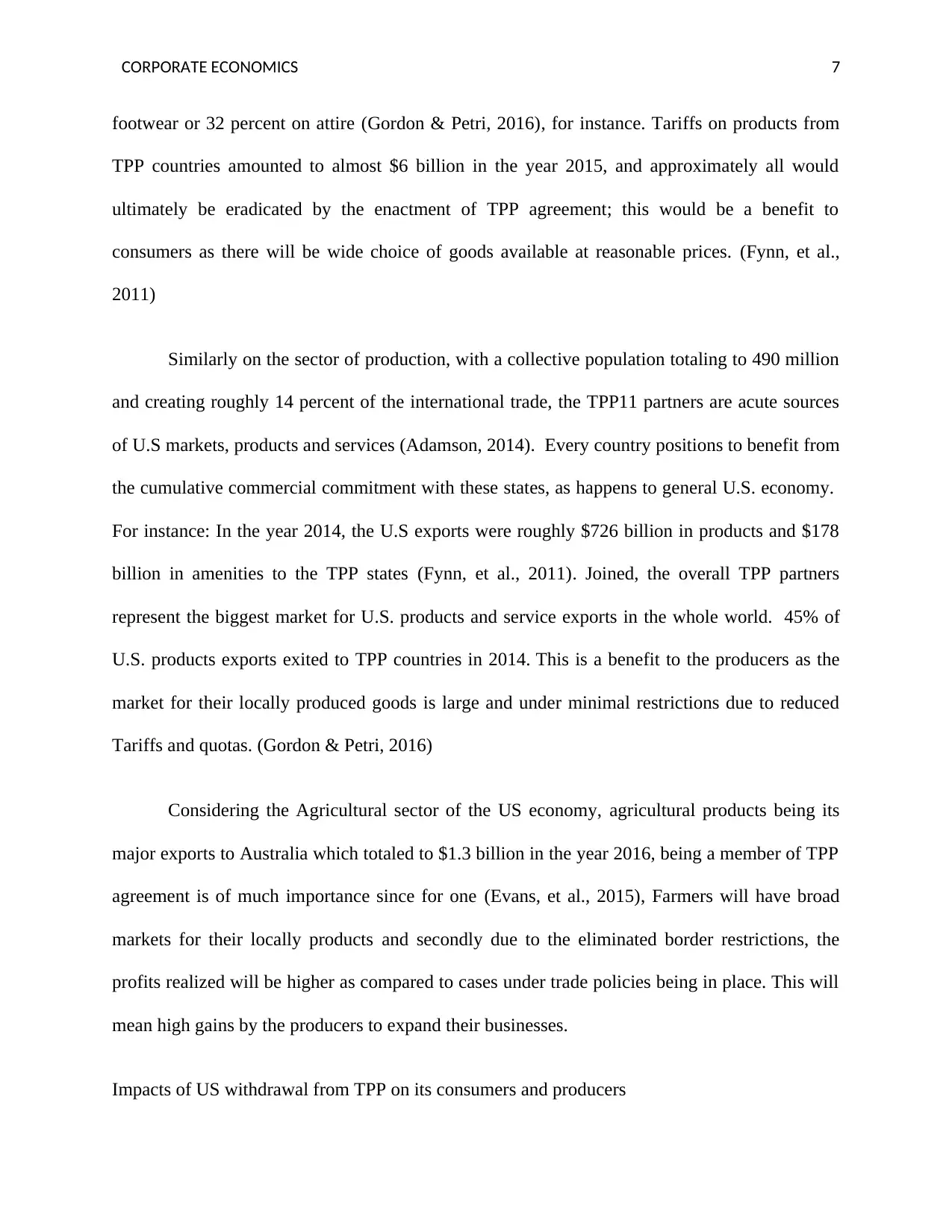
CORPORATE ECONOMICS 7
footwear or 32 percent on attire (Gordon & Petri, 2016), for instance. Tariffs on products from
TPP countries amounted to almost $6 billion in the year 2015, and approximately all would
ultimately be eradicated by the enactment of TPP agreement; this would be a benefit to
consumers as there will be wide choice of goods available at reasonable prices. (Fynn, et al.,
2011)
Similarly on the sector of production, with a collective population totaling to 490 million
and creating roughly 14 percent of the international trade, the TPP11 partners are acute sources
of U.S markets, products and services (Adamson, 2014). Every country positions to benefit from
the cumulative commercial commitment with these states, as happens to general U.S. economy.
For instance: In the year 2014, the U.S exports were roughly $726 billion in products and $178
billion in amenities to the TPP states (Fynn, et al., 2011). Joined, the overall TPP partners
represent the biggest market for U.S. products and service exports in the whole world. 45% of
U.S. products exports exited to TPP countries in 2014. This is a benefit to the producers as the
market for their locally produced goods is large and under minimal restrictions due to reduced
Tariffs and quotas. (Gordon & Petri, 2016)
Considering the Agricultural sector of the US economy, agricultural products being its
major exports to Australia which totaled to $1.3 billion in the year 2016, being a member of TPP
agreement is of much importance since for one (Evans, et al., 2015), Farmers will have broad
markets for their locally products and secondly due to the eliminated border restrictions, the
profits realized will be higher as compared to cases under trade policies being in place. This will
mean high gains by the producers to expand their businesses.
Impacts of US withdrawal from TPP on its consumers and producers
footwear or 32 percent on attire (Gordon & Petri, 2016), for instance. Tariffs on products from
TPP countries amounted to almost $6 billion in the year 2015, and approximately all would
ultimately be eradicated by the enactment of TPP agreement; this would be a benefit to
consumers as there will be wide choice of goods available at reasonable prices. (Fynn, et al.,
2011)
Similarly on the sector of production, with a collective population totaling to 490 million
and creating roughly 14 percent of the international trade, the TPP11 partners are acute sources
of U.S markets, products and services (Adamson, 2014). Every country positions to benefit from
the cumulative commercial commitment with these states, as happens to general U.S. economy.
For instance: In the year 2014, the U.S exports were roughly $726 billion in products and $178
billion in amenities to the TPP states (Fynn, et al., 2011). Joined, the overall TPP partners
represent the biggest market for U.S. products and service exports in the whole world. 45% of
U.S. products exports exited to TPP countries in 2014. This is a benefit to the producers as the
market for their locally produced goods is large and under minimal restrictions due to reduced
Tariffs and quotas. (Gordon & Petri, 2016)
Considering the Agricultural sector of the US economy, agricultural products being its
major exports to Australia which totaled to $1.3 billion in the year 2016, being a member of TPP
agreement is of much importance since for one (Evans, et al., 2015), Farmers will have broad
markets for their locally products and secondly due to the eliminated border restrictions, the
profits realized will be higher as compared to cases under trade policies being in place. This will
mean high gains by the producers to expand their businesses.
Impacts of US withdrawal from TPP on its consumers and producers
Paraphrase This Document
Need a fresh take? Get an instant paraphrase of this document with our AI Paraphraser
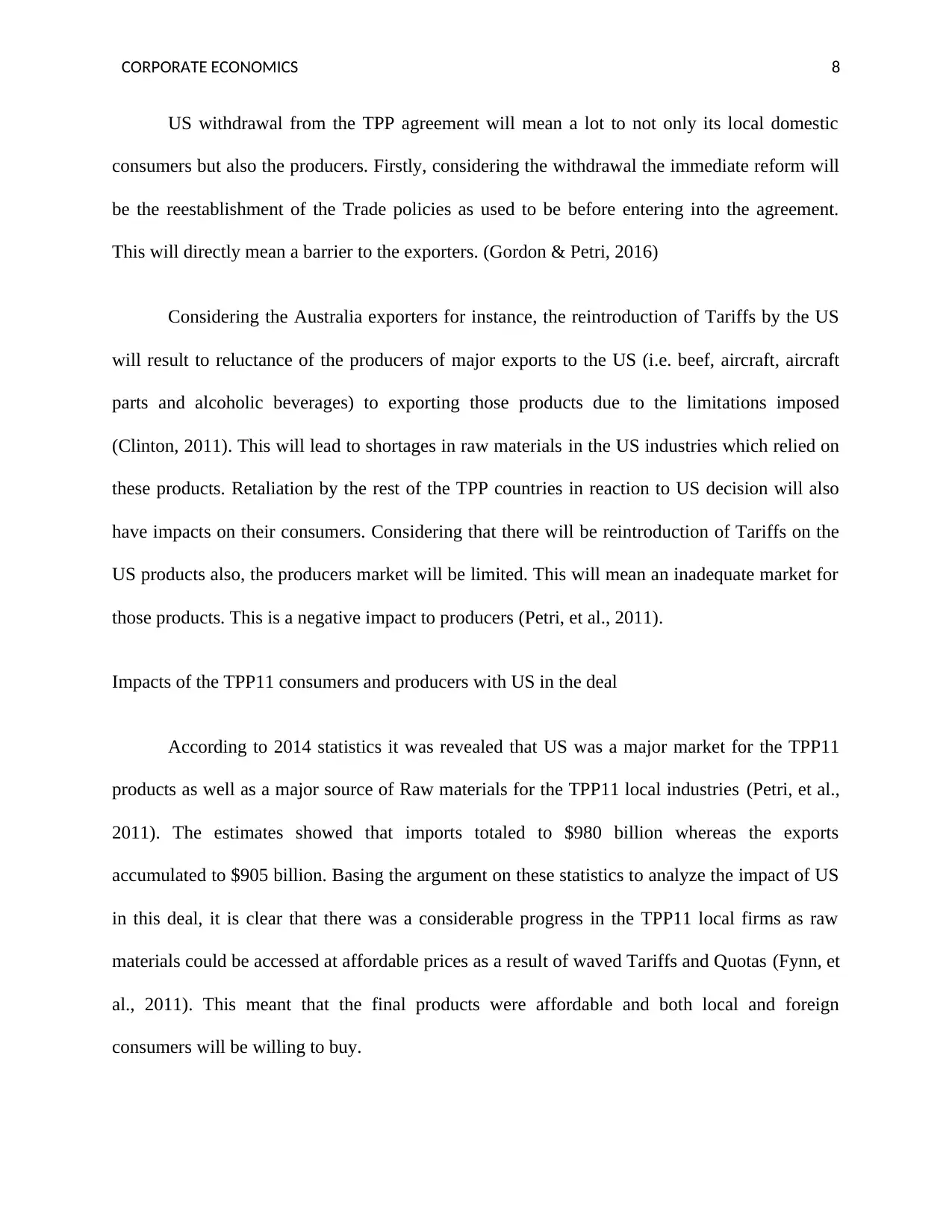
CORPORATE ECONOMICS 8
US withdrawal from the TPP agreement will mean a lot to not only its local domestic
consumers but also the producers. Firstly, considering the withdrawal the immediate reform will
be the reestablishment of the Trade policies as used to be before entering into the agreement.
This will directly mean a barrier to the exporters. (Gordon & Petri, 2016)
Considering the Australia exporters for instance, the reintroduction of Tariffs by the US
will result to reluctance of the producers of major exports to the US (i.e. beef, aircraft, aircraft
parts and alcoholic beverages) to exporting those products due to the limitations imposed
(Clinton, 2011). This will lead to shortages in raw materials in the US industries which relied on
these products. Retaliation by the rest of the TPP countries in reaction to US decision will also
have impacts on their consumers. Considering that there will be reintroduction of Tariffs on the
US products also, the producers market will be limited. This will mean an inadequate market for
those products. This is a negative impact to producers (Petri, et al., 2011).
Impacts of the TPP11 consumers and producers with US in the deal
According to 2014 statistics it was revealed that US was a major market for the TPP11
products as well as a major source of Raw materials for the TPP11 local industries (Petri, et al.,
2011). The estimates showed that imports totaled to $980 billion whereas the exports
accumulated to $905 billion. Basing the argument on these statistics to analyze the impact of US
in this deal, it is clear that there was a considerable progress in the TPP11 local firms as raw
materials could be accessed at affordable prices as a result of waved Tariffs and Quotas (Fynn, et
al., 2011). This meant that the final products were affordable and both local and foreign
consumers will be willing to buy.
US withdrawal from the TPP agreement will mean a lot to not only its local domestic
consumers but also the producers. Firstly, considering the withdrawal the immediate reform will
be the reestablishment of the Trade policies as used to be before entering into the agreement.
This will directly mean a barrier to the exporters. (Gordon & Petri, 2016)
Considering the Australia exporters for instance, the reintroduction of Tariffs by the US
will result to reluctance of the producers of major exports to the US (i.e. beef, aircraft, aircraft
parts and alcoholic beverages) to exporting those products due to the limitations imposed
(Clinton, 2011). This will lead to shortages in raw materials in the US industries which relied on
these products. Retaliation by the rest of the TPP countries in reaction to US decision will also
have impacts on their consumers. Considering that there will be reintroduction of Tariffs on the
US products also, the producers market will be limited. This will mean an inadequate market for
those products. This is a negative impact to producers (Petri, et al., 2011).
Impacts of the TPP11 consumers and producers with US in the deal
According to 2014 statistics it was revealed that US was a major market for the TPP11
products as well as a major source of Raw materials for the TPP11 local industries (Petri, et al.,
2011). The estimates showed that imports totaled to $980 billion whereas the exports
accumulated to $905 billion. Basing the argument on these statistics to analyze the impact of US
in this deal, it is clear that there was a considerable progress in the TPP11 local firms as raw
materials could be accessed at affordable prices as a result of waved Tariffs and Quotas (Fynn, et
al., 2011). This meant that the final products were affordable and both local and foreign
consumers will be willing to buy.
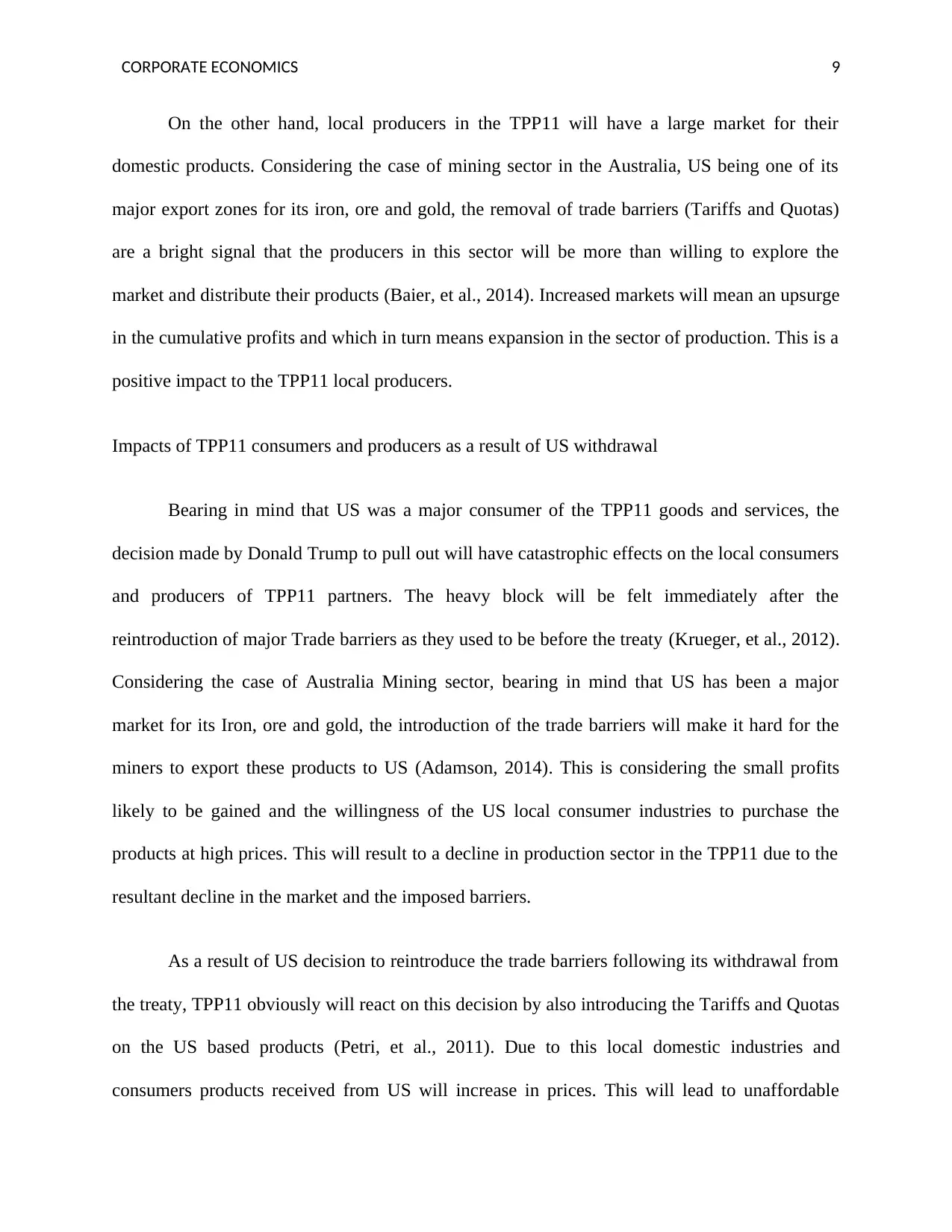
CORPORATE ECONOMICS 9
On the other hand, local producers in the TPP11 will have a large market for their
domestic products. Considering the case of mining sector in the Australia, US being one of its
major export zones for its iron, ore and gold, the removal of trade barriers (Tariffs and Quotas)
are a bright signal that the producers in this sector will be more than willing to explore the
market and distribute their products (Baier, et al., 2014). Increased markets will mean an upsurge
in the cumulative profits and which in turn means expansion in the sector of production. This is a
positive impact to the TPP11 local producers.
Impacts of TPP11 consumers and producers as a result of US withdrawal
Bearing in mind that US was a major consumer of the TPP11 goods and services, the
decision made by Donald Trump to pull out will have catastrophic effects on the local consumers
and producers of TPP11 partners. The heavy block will be felt immediately after the
reintroduction of major Trade barriers as they used to be before the treaty (Krueger, et al., 2012).
Considering the case of Australia Mining sector, bearing in mind that US has been a major
market for its Iron, ore and gold, the introduction of the trade barriers will make it hard for the
miners to export these products to US (Adamson, 2014). This is considering the small profits
likely to be gained and the willingness of the US local consumer industries to purchase the
products at high prices. This will result to a decline in production sector in the TPP11 due to the
resultant decline in the market and the imposed barriers.
As a result of US decision to reintroduce the trade barriers following its withdrawal from
the treaty, TPP11 obviously will react on this decision by also introducing the Tariffs and Quotas
on the US based products (Petri, et al., 2011). Due to this local domestic industries and
consumers products received from US will increase in prices. This will lead to unaffordable
On the other hand, local producers in the TPP11 will have a large market for their
domestic products. Considering the case of mining sector in the Australia, US being one of its
major export zones for its iron, ore and gold, the removal of trade barriers (Tariffs and Quotas)
are a bright signal that the producers in this sector will be more than willing to explore the
market and distribute their products (Baier, et al., 2014). Increased markets will mean an upsurge
in the cumulative profits and which in turn means expansion in the sector of production. This is a
positive impact to the TPP11 local producers.
Impacts of TPP11 consumers and producers as a result of US withdrawal
Bearing in mind that US was a major consumer of the TPP11 goods and services, the
decision made by Donald Trump to pull out will have catastrophic effects on the local consumers
and producers of TPP11 partners. The heavy block will be felt immediately after the
reintroduction of major Trade barriers as they used to be before the treaty (Krueger, et al., 2012).
Considering the case of Australia Mining sector, bearing in mind that US has been a major
market for its Iron, ore and gold, the introduction of the trade barriers will make it hard for the
miners to export these products to US (Adamson, 2014). This is considering the small profits
likely to be gained and the willingness of the US local consumer industries to purchase the
products at high prices. This will result to a decline in production sector in the TPP11 due to the
resultant decline in the market and the imposed barriers.
As a result of US decision to reintroduce the trade barriers following its withdrawal from
the treaty, TPP11 obviously will react on this decision by also introducing the Tariffs and Quotas
on the US based products (Petri, et al., 2011). Due to this local domestic industries and
consumers products received from US will increase in prices. This will lead to unaffordable
⊘ This is a preview!⊘
Do you want full access?
Subscribe today to unlock all pages.

Trusted by 1+ million students worldwide
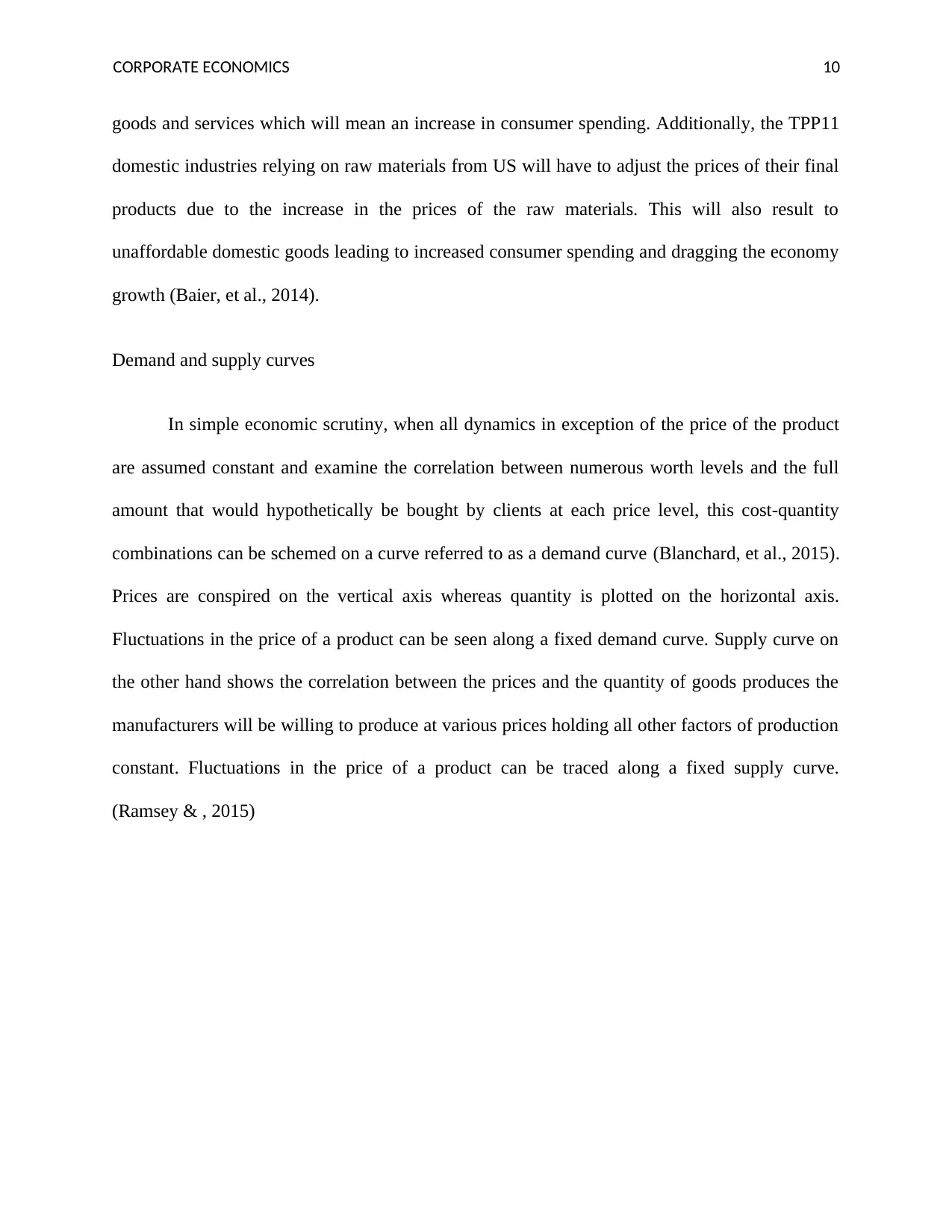
CORPORATE ECONOMICS 10
goods and services which will mean an increase in consumer spending. Additionally, the TPP11
domestic industries relying on raw materials from US will have to adjust the prices of their final
products due to the increase in the prices of the raw materials. This will also result to
unaffordable domestic goods leading to increased consumer spending and dragging the economy
growth (Baier, et al., 2014).
Demand and supply curves
In simple economic scrutiny, when all dynamics in exception of the price of the product
are assumed constant and examine the correlation between numerous worth levels and the full
amount that would hypothetically be bought by clients at each price level, this cost-quantity
combinations can be schemed on a curve referred to as a demand curve (Blanchard, et al., 2015).
Prices are conspired on the vertical axis whereas quantity is plotted on the horizontal axis.
Fluctuations in the price of a product can be seen along a fixed demand curve. Supply curve on
the other hand shows the correlation between the prices and the quantity of goods produces the
manufacturers will be willing to produce at various prices holding all other factors of production
constant. Fluctuations in the price of a product can be traced along a fixed supply curve.
(Ramsey & , 2015)
goods and services which will mean an increase in consumer spending. Additionally, the TPP11
domestic industries relying on raw materials from US will have to adjust the prices of their final
products due to the increase in the prices of the raw materials. This will also result to
unaffordable domestic goods leading to increased consumer spending and dragging the economy
growth (Baier, et al., 2014).
Demand and supply curves
In simple economic scrutiny, when all dynamics in exception of the price of the product
are assumed constant and examine the correlation between numerous worth levels and the full
amount that would hypothetically be bought by clients at each price level, this cost-quantity
combinations can be schemed on a curve referred to as a demand curve (Blanchard, et al., 2015).
Prices are conspired on the vertical axis whereas quantity is plotted on the horizontal axis.
Fluctuations in the price of a product can be seen along a fixed demand curve. Supply curve on
the other hand shows the correlation between the prices and the quantity of goods produces the
manufacturers will be willing to produce at various prices holding all other factors of production
constant. Fluctuations in the price of a product can be traced along a fixed supply curve.
(Ramsey & , 2015)
Paraphrase This Document
Need a fresh take? Get an instant paraphrase of this document with our AI Paraphraser
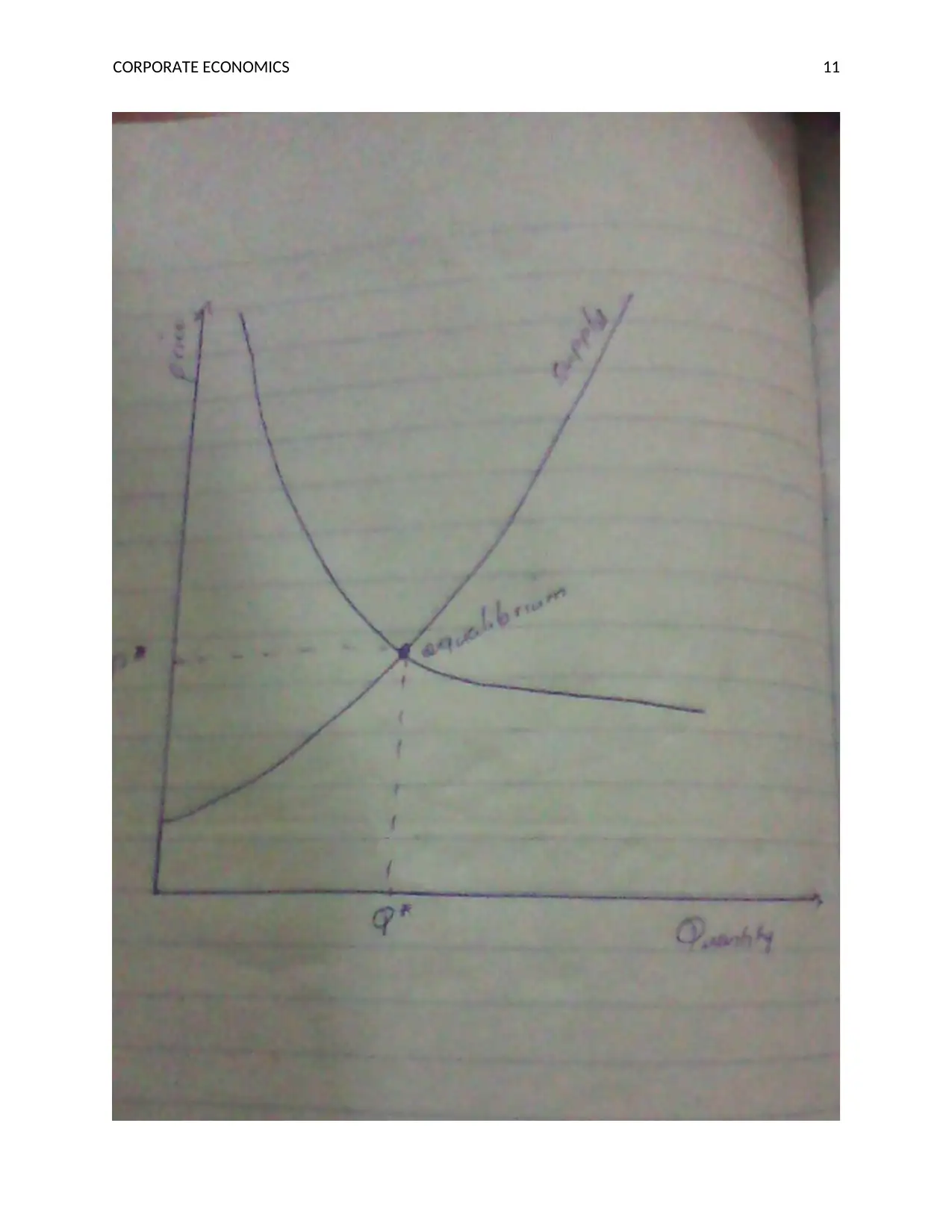
CORPORATE ECONOMICS 11
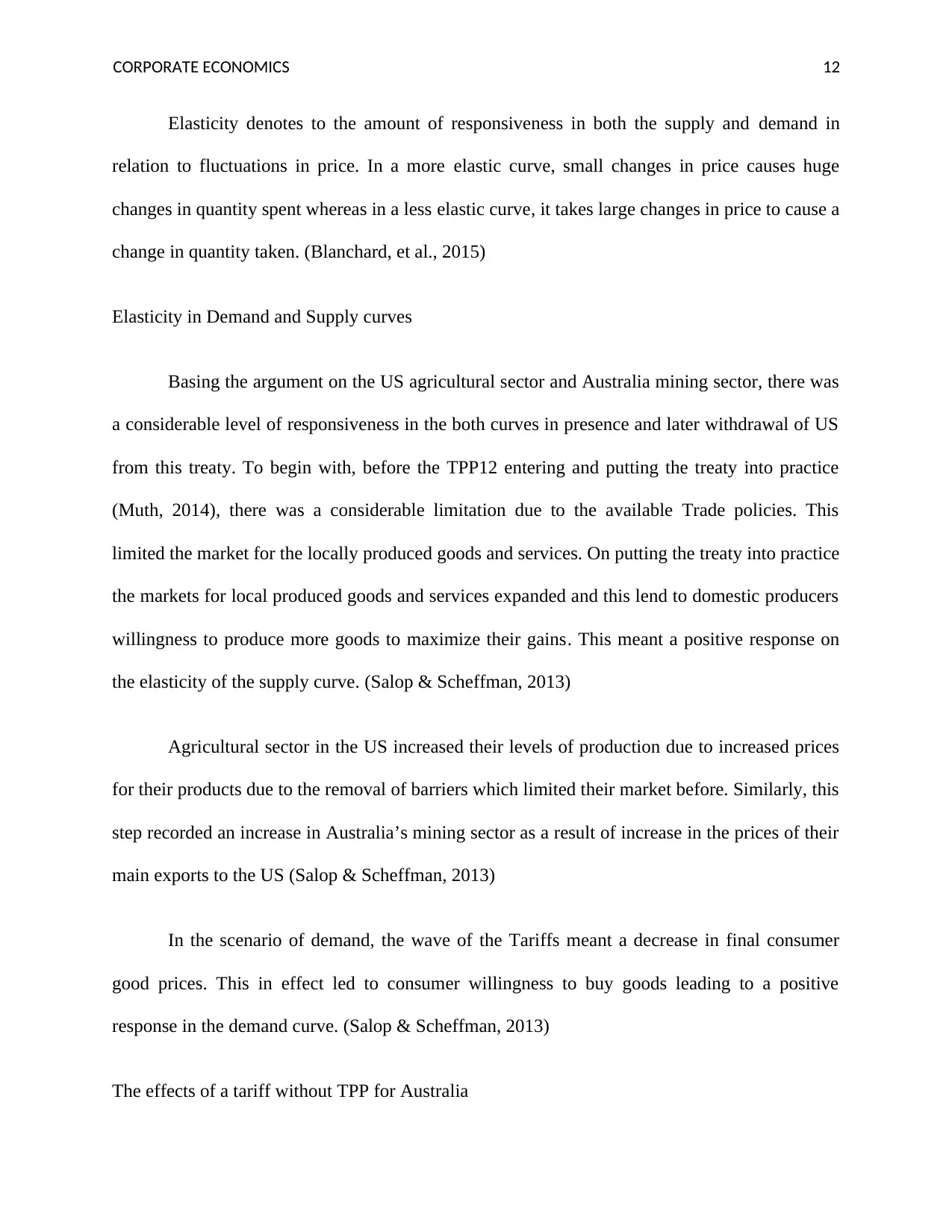
CORPORATE ECONOMICS 12
Elasticity denotes to the amount of responsiveness in both the supply and demand in
relation to fluctuations in price. In a more elastic curve, small changes in price causes huge
changes in quantity spent whereas in a less elastic curve, it takes large changes in price to cause a
change in quantity taken. (Blanchard, et al., 2015)
Elasticity in Demand and Supply curves
Basing the argument on the US agricultural sector and Australia mining sector, there was
a considerable level of responsiveness in the both curves in presence and later withdrawal of US
from this treaty. To begin with, before the TPP12 entering and putting the treaty into practice
(Muth, 2014), there was a considerable limitation due to the available Trade policies. This
limited the market for the locally produced goods and services. On putting the treaty into practice
the markets for local produced goods and services expanded and this lend to domestic producers
willingness to produce more goods to maximize their gains. This meant a positive response on
the elasticity of the supply curve. (Salop & Scheffman, 2013)
Agricultural sector in the US increased their levels of production due to increased prices
for their products due to the removal of barriers which limited their market before. Similarly, this
step recorded an increase in Australia’s mining sector as a result of increase in the prices of their
main exports to the US (Salop & Scheffman, 2013)
In the scenario of demand, the wave of the Tariffs meant a decrease in final consumer
good prices. This in effect led to consumer willingness to buy goods leading to a positive
response in the demand curve. (Salop & Scheffman, 2013)
The effects of a tariff without TPP for Australia
Elasticity denotes to the amount of responsiveness in both the supply and demand in
relation to fluctuations in price. In a more elastic curve, small changes in price causes huge
changes in quantity spent whereas in a less elastic curve, it takes large changes in price to cause a
change in quantity taken. (Blanchard, et al., 2015)
Elasticity in Demand and Supply curves
Basing the argument on the US agricultural sector and Australia mining sector, there was
a considerable level of responsiveness in the both curves in presence and later withdrawal of US
from this treaty. To begin with, before the TPP12 entering and putting the treaty into practice
(Muth, 2014), there was a considerable limitation due to the available Trade policies. This
limited the market for the locally produced goods and services. On putting the treaty into practice
the markets for local produced goods and services expanded and this lend to domestic producers
willingness to produce more goods to maximize their gains. This meant a positive response on
the elasticity of the supply curve. (Salop & Scheffman, 2013)
Agricultural sector in the US increased their levels of production due to increased prices
for their products due to the removal of barriers which limited their market before. Similarly, this
step recorded an increase in Australia’s mining sector as a result of increase in the prices of their
main exports to the US (Salop & Scheffman, 2013)
In the scenario of demand, the wave of the Tariffs meant a decrease in final consumer
good prices. This in effect led to consumer willingness to buy goods leading to a positive
response in the demand curve. (Salop & Scheffman, 2013)
The effects of a tariff without TPP for Australia
⊘ This is a preview!⊘
Do you want full access?
Subscribe today to unlock all pages.

Trusted by 1+ million students worldwide
1 out of 23
Related Documents
Your All-in-One AI-Powered Toolkit for Academic Success.
+13062052269
info@desklib.com
Available 24*7 on WhatsApp / Email
![[object Object]](/_next/static/media/star-bottom.7253800d.svg)
Unlock your academic potential
Copyright © 2020–2025 A2Z Services. All Rights Reserved. Developed and managed by ZUCOL.





